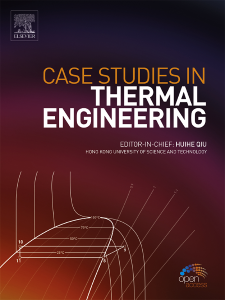Artificial intelligence and numerical study of the heat transfer and entropy generation analysis of NEPCM-MWCNTs-Water Hybrid Nanofluids inside a quadrilateral enclosure
IF 6.4
2区 工程技术
Q1 THERMODYNAMICS
引用次数: 0
Abstract
In the present investigation, the primary objective is to assess the synergistic impact of a novel hybrid nanofluid composed of nano-enhanced phase change material, multi-walled carbon nanotubes, and water. The governing equations are transformed into dimensionless forms for a more generalized analysis. To solve the problem, the Galerkin finite element method is employed, offering a robust numerical approach. A dataset of 1000 records was created by numerically solving the model for various combinations of control parameters. Using the dataset, a neural network was trained to learn the relationship between control parameters and heat transfer rate. The evaluation outcomes are comprehensively illustrated through key parameters, including local and average Nusselt numbers, total entropy generation, contours, and streamlines in the range of 103<Rayleigh number<105, 0<nanotube concentration<0.025, 0<nano capsule concentration <0.025, and 0.1<non-dimensional fusion temperature <0.7. Remarkably, the results indicate a substantial improvement in the heat transfer rate of the suspension for a hybrid concentration of 5 %, showcasing an impressive 13 % enhancement in contrast to the water host fluid's performance. Notably, the observed rise in entropy generation is relatively moderate, only a 5 % increase.
四边形围墙内 NEPCM-MWCNTs-Water 混合纳米流体传热和熵生成分析的人工智能和数值研究
本研究的主要目的是评估由纳米增强相变材料、多壁碳纳米管和水组成的新型混合纳米流体的协同影响。为进行更广泛的分析,将控制方程转换为无量纲形式。为了解决这个问题,采用了 Galerkin 有限元方法,提供了一种稳健的数值方法。通过对各种控制参数组合的模型进行数值求解,创建了一个包含 1000 条记录的数据集。利用该数据集,对神经网络进行了训练,以学习控制参数与传热率之间的关系。在 103<雷利数<105、0<纳米管浓度<0.025、0<纳米胶囊浓度<0.025 和 0.1<非维度融合温度<0.7 的范围内,通过关键参数(包括局部和平均努塞尔特数、总熵生成、等值线和流线)全面说明了评估结果。值得注意的是,结果表明,当混合浓度为 5% 时,悬浮液的传热率大幅提高,与水主流体的性能相比,提高了 13%,令人印象深刻。值得注意的是,观察到的熵增相对较小,仅增加了 5%。
本文章由计算机程序翻译,如有差异,请以英文原文为准。
求助全文
约1分钟内获得全文
求助全文
来源期刊

Case Studies in Thermal Engineering
Chemical Engineering-Fluid Flow and Transfer Processes
CiteScore
8.60
自引率
11.80%
发文量
812
审稿时长
76 days
期刊介绍:
Case Studies in Thermal Engineering provides a forum for the rapid publication of short, structured Case Studies in Thermal Engineering and related Short Communications. It provides an essential compendium of case studies for researchers and practitioners in the field of thermal engineering and others who are interested in aspects of thermal engineering cases that could affect other engineering processes. The journal not only publishes new and novel case studies, but also provides a forum for the publication of high quality descriptions of classic thermal engineering problems. The scope of the journal includes case studies of thermal engineering problems in components, devices and systems using existing experimental and numerical techniques in the areas of mechanical, aerospace, chemical, medical, thermal management for electronics, heat exchangers, regeneration, solar thermal energy, thermal storage, building energy conservation, and power generation. Case studies of thermal problems in other areas will also be considered.
 求助内容:
求助内容: 应助结果提醒方式:
应助结果提醒方式:


